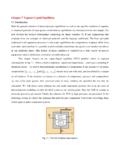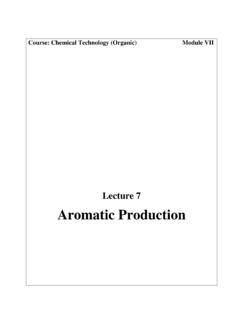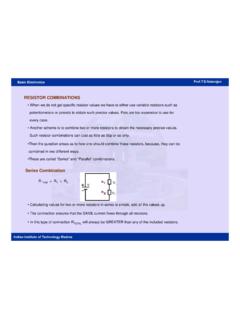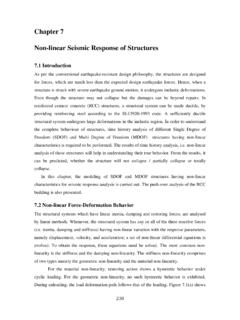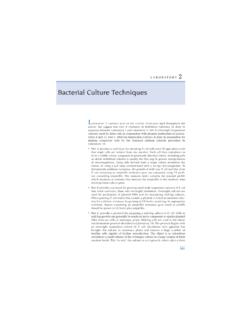Transcription of MODULE 4- LECTURE 1 ISOLATION AND PURIFICATION OF …
1 NPTEL Bio Technology Genetic Engineering & Applications MODULE 4- LECTURE 1. ISOLATION AND PURIFICATION OF NUCLEIC ACIDS. (GENOMIC/PLASMID DNA AND RNA). Introduction Every gene manipulation procedure requires genetic material like DNA and RNA. Nucleic acids occur naturally in association with proteins and lipoprotein organelles. The dissociation of a nucleoprotein into nucleic acid and protein moieties and their subsequent separation, are the essential steps in the ISOLATION of all species of nucleic acids. ISOLATION of nucleic acids is followed by quantitation of nucleic acids generally done by either spectrophotometric or by using fluorescent dyes to determine the average concentrations and purity of DNA or RNA present in a mixture.
2 Isolating the genetic material (DNA) from cells (bacterial, viral, plant or animal) involves three basic steps- Rupturing of cell membrane to release the cellular components and DNA. Separation of the nucleic acids from other cellular components PURIFICATION of nucleic acids ISOLATION and PURIFICATION of Genomic DNA. Genomic DNA is found in the nucleus of all living cells with the structure of double- stranded DNA remaining unchanged (helical ribbon). The ISOLATION of genomic DNA. differs in animals and plant cells. DNA ISOLATION from plant cells is difficult due to the presence of cell wall, as compared to animal cells.
3 The amount and purity of extracted DNA depends on the nature of the cell. The method of ISOLATION of genomic DNA from a bacterium comprises following steps (Figure )- 1. Bacterial culture growth and harvest. 2. Cell wall rupture and cell extract preparation. Joint initiative of IITs and IISc Funded by MHRD Page 1 of 57. NPTEL Bio Technology Genetic Engineering & Applications 3. DNA PURIFICATION from the cell extract. 4. Concentration of DNA solution. Growth and harvest of bacterial culture Bacterial cell culture is more convenient than any other microbe, as it requires only liquid medium ( broth ) containing essential nutrients at optimal concentrations, for the growth and division of bacterial cells.
4 The bacterial cells are usually grown on a complex medium like luria -Bertani (LB), in which the medium composition is difficult to decipher. Later, the cells are separated by centrifugation and resuspended in 1% or less of the initial culture volume. Preparation of cell extract Bacterial cell is surrounded by an additional layer called cell wall, apart from plasma membrane with some species of E. coli comprising multilayered cell wall. The lysis of cell wall to release the genetic material DNA can be achieved by following ways- Physical method by mechanical forces.
5 Chemical method by metal chelating agents EDTA and surfactant SDS. or enzyme ( lysozyme). Lysozyme present in egg-white, salivary secretion and tears. catalyzes the breakdown of cell wall the peptidoglycan layer. EDTA (Ethylene diamine tetra-acetic acid). a chelating agent necessary for destabilizing the integrity of cell wall. inhibits the cellular enzymes that degrade DNA. SDS (Sodium dodecyl sulphate). helps in removal of lipid molecules and denaturation of membrane proteins. Joint initiative of IITs and IISc Funded by MHRD Page 2 of 57.
6 NPTEL Bio Technology Genetic Engineering & Applications Generally, a mixture of EDTA and lysozyme is used. Cell lysis is followed by centrifugation to pellet down the cell wall fractions leaving a clear supernatant containing cell extract. PURIFICATION of DNA. In addition to DNA, a cell extract contains significant quantities of protein and RNA. which can be further purified by following methods- Organic extraction and enzymatic digestion for the removal of contaminants It involves the addition of a mixture of phenol and chloroform (1:1) to the cell lysate for protein separation.
7 The proteins aggregate as a white mass in between the aqueous phase containing DNA and RNA, and the organic layer. Treatment of lysate with pronase or protease, in addition to phenol/chloroform, ensures complete removal of proteins from the extract. The RNA can be effectively removed by using Ribonuclease, an enzyme which rapidly degrades RNA into its ribonucleotide subunits. Repeated phenol extraction is not desirable, as it damages the DNA. Using ion-exchange chromatography This involves the separation of ions and polar molecules (proteins, small nucleotides and amino acids) based on their charge.
8 DNA carrying negative charge binds to the cationic resin or matrix which can be eluted from the column by salt gradient. Gradual increase in salt concentration detaches molecules from the resin one after another. Figure Preparation of genomic DNA. Joint initiative of IITs and IISc Funded by MHRD Page 3 of 57. NPTEL Bio Technology Genetic Engineering & Applications Concentration of DNA samples Concentration of DNA can be done using ethanol along with salts such as sodium acetate, potassium acetate etc. These salts provide metal ions like sodium ions (Na+), potassium ions (K+) which help in aggregation and hence precipitation of DNA molecules.
9 Advantage It leaves short-chain and monomeric nucleic acid components in solution. Ribonucleotides produced by the ribonuclease treatment are separated from DNA. ISOLATION and PURIFICATION of Plasmid DNA. Plasmids are circular, double stranded extra cellular DNA molecules of bacterium and most commonly used in recombinant DNA technology. The ISOLATION of plasmid DNA. involves three major steps- 1. Growth of the bacterial cell. 2. Harvesting and lysis of the bacteria. 3. PURIFICATION of the plasmid DNA. Growth of the bacterial cell It involves growth of the bacterial cells in a media containing essential nutrients.
10 Harvest and lysis of bacteria Lysis of bacteria results in the precipitation of DNA and cellular proteins. Addition of acetate-containing neutralization buffer results in the precipitation of large and less supercoiled chromosomal DNA and proteins leaving the small bacterial DNA plasmids in solution. PURIFICATION of Plasmid DNA. This step is same for both plasmid and genomic but former involves an additional step the separation of plasmid DNA from the large bacterial chromosomal DNA. Joint initiative of IITs and IISc Funded by MHRD Page 4 of 57.
